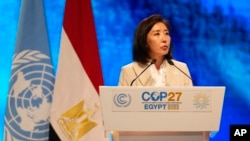The United States’ commitment to providing extended deterrence to South Korea is being put to the test, with some South Korean politicians publicly questioning the effectiveness of the U.S. nuclear umbrella after Russia and North Korea reached a new defense pact.
Debate over the U.S. extended deterrence was sparked by Representative Na Kyung Won, a five-term lawmaker of South Korea’s ruling People Power Party, who is running for the party leadership.
“The deterrence under the solid South Korea-U.S. alliance is currently working, but it does not guarantee the capacity to respond to the future changes in the security environment,” Na said in a social media post last week.
“The international situation, such as cooperation between North Korea and Russia, is adding uncertainty to the security of South Korea,” she added, referring to the stronger military ties between Russia and North Korea, bolstered by the comprehensive strategic partnership treaty signed by Russia’s President Vladmir Putin and North Korean leader Kim Jong Un in Pyongyang last month.
The new treaty mandates Russia and North Korea to immediately assist each other militarily if either of them is attacked by a third country. The prospect of quasi-automatic Russian involvement in any future war between the two Koreas is now causing alarm in Seoul.
The credibility of extended deterrence is a frequent topic of conversation in today’s South Korea, where citizens must contend with seemingly endless threats and provocations from the North.
Seoul is doing its best to allay citizens’ fears by invoking the April 2023 Washington Declaration, which reaffirmed the U.S. commitment to defend South Korea through its extended nuclear umbrella as well as robust missile defense and conventional forces.
The Washington Declaration outlined a series of measures, including the establishment of the bilateral Nuclear Consultative Group (NCG), to deter North Korea’s use of nuclear weapons.
In the joint declaration, the U.S. additionally vowed to enhance the visibility of its strategic assets, such as a nuclear-armed submarine, around the Korean Peninsula.
The Washington Declaration’s measures are collectively sufficient to deter aggression from Pyongyang, according to some experts in the U.S.
The joint declaration was “unprecedented in its strength and clarity,” Evans Revere, a former State Department official who negotiated with North Korea, told VOA’s Korean Service on Sunday. “And the NCG process is designed to be flexible, creative, and allow for adaptation to a broad range of future contingencies.”
Troop presence
David Maxwell, a former U.S. Special Forces colonel who served on the Combined Forces Command of the U.S and South Korea, told VOA’s Korean Service on Sunday that a large troop presence on the Korean Peninsula demonstrates Washington’s firm commitment to the defense of its key ally.
“How many Russian troops are committed to North Korea? There is no comparison as to the commitment,” said Maxwell, who now serves as vice president of the Center for Asia Pacific Strategy.
Currently, the U.S. has about 28,500 service members deployed in South Korea.
In contrast, Elbridge Colby, who served as the deputy assistant secretary of defense for strategy and force development in the Trump administration, suggested the U.S. might have to go beyond the Washington Declaration to ensure the security of South Korea.
“I think we need to take very seriously how dire the threat from North Korea is, and that the Washington Declaration is not a solution,” Colby told VOA’s Korean Service on the phone last week.
“It’s been a failure that both North Korea and China are a nuclear breakout. They’re increasing the size and the sophistication of the nuclear forces. So it’s very unsurprising that serious people in South Korea are coming to this conclusion.”
Bruce Bennett, senior defense analyst at the RAND Corporation, believes some South Koreans may lack confidence in the Washington Declaration because the NCG’s work is not made public.
“Because the NCG that it established has carried out most of its work in secrecy and provided little substance to reassure the South Korean people, many of the South Koreans with whom I have spoken are concerned that it is an inadequate means for rebuilding South Korean trust,” Bennett told VOA’s Korean Service on Sunday.
Responding to an inquiry from VOA’s Korean Service, a State Department spokesperson said Thursday that "the U.S. and the ROK are enhancing and strengthening extended deterrence through the Nuclear Consultative Group, established as part of the Washington Declaration.”
The spokesperson also stressed that the Washington Declaration is “a landmark U.S. extended deterrence commitment to the Republic of Korea.” The Republic of Korea is South Korea’s official name.
Earlier last week, U.S. Deputy Secretary of State Kurt Campbell maintained that the series of mechanisms put in place between the United States and South Korea through the Washington Declaration “has given us what we need to work with” regarding the alliance’s deterrence posture.
North Korea launched two short-range ballistic missiles Monday, one of which is presumed to have failed and fallen inland near Pyongyang. The latest missile test came just five days after North Korea conducted a ballistic missile test in which it claimed to have successfully tested its multiple-warhead missile technology. South Korean authorities have dismissed such a claim.
Eunjung Cho contributed to this report.









